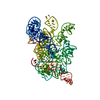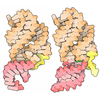+ Open data
Open data
- Basic information
Basic information
| Entry | Database: PDB / ID: 9cbu | |||||||||||||||||||||||||||||||||
|---|---|---|---|---|---|---|---|---|---|---|---|---|---|---|---|---|---|---|---|---|---|---|---|---|---|---|---|---|---|---|---|---|---|---|
| Title | Tetrahymena ribozyme with consensus water and magnesium ions | |||||||||||||||||||||||||||||||||
 Components Components | RNA (387-MER) | |||||||||||||||||||||||||||||||||
 Keywords Keywords | RNA / Ribozyme / Magnesium ions / Water | |||||||||||||||||||||||||||||||||
| Function / homology | : / RNA / RNA (> 10) / RNA (> 100) Function and homology information Function and homology information | |||||||||||||||||||||||||||||||||
| Biological species |  | |||||||||||||||||||||||||||||||||
| Method | ELECTRON MICROSCOPY / single particle reconstruction / cryo EM / Resolution: 2.2 Å | |||||||||||||||||||||||||||||||||
 Authors Authors | Kretsch, R.C. / Li, S. / Pintilie, G. / Palo, M.Z. / Case, D.A. / Das, R. / Zhang, K. / Chiu, W. | |||||||||||||||||||||||||||||||||
| Funding support |  United States, United States,  China, 10items China, 10items
| |||||||||||||||||||||||||||||||||
 Citation Citation |  Journal: Nature / Year: 2025 Journal: Nature / Year: 2025Title: Complex water networks visualized by cryogenic electron microscopy of RNA. Authors: Rachael C Kretsch / Shanshan Li / Grigore Pintilie / Michael Z Palo / David A Case / Rhiju Das / Kaiming Zhang / Wah Chiu /   Abstract: The stability and function of biomolecules are directly influenced by their myriad interactions with water. Here we investigated water through cryogenic electron microscopy (cryo-EM) on a highly ...The stability and function of biomolecules are directly influenced by their myriad interactions with water. Here we investigated water through cryogenic electron microscopy (cryo-EM) on a highly solvated molecule: the Tetrahymena ribozyme. By using segmentation-guided water and ion modelling (SWIM), an approach combining resolvability and chemical parameters, we automatically modelled and cross-validated water molecules and Mg ions in the ribozyme core, revealing the extensive involvement of water in mediating RNA non-canonical interactions. Unexpectedly, in regions where SWIM does not model ordered water, we observed highly similar densities in both cryo-EM maps. In many of these regions, the cryo-EM densities superimpose with complex water networks predicted by molecular dynamics, supporting their assignment as water and suggesting a biophysical explanation for their elusiveness to conventional atomic coordinate modelling. Our study demonstrates an approach to unveil both rigid and flexible waters that surround biomolecules through cryo-EM map densities, statistical and chemical metrics, and molecular dynamics simulations. | |||||||||||||||||||||||||||||||||
| History |
|
- Structure visualization
Structure visualization
| Structure viewer | Molecule:  Molmil Molmil Jmol/JSmol Jmol/JSmol |
|---|
- Downloads & links
Downloads & links
- Download
Download
| PDBx/mmCIF format |  9cbu.cif.gz 9cbu.cif.gz | 234.4 KB | Display |  PDBx/mmCIF format PDBx/mmCIF format |
|---|---|---|---|---|
| PDB format |  pdb9cbu.ent.gz pdb9cbu.ent.gz | 169.5 KB | Display |  PDB format PDB format |
| PDBx/mmJSON format |  9cbu.json.gz 9cbu.json.gz | Tree view |  PDBx/mmJSON format PDBx/mmJSON format | |
| Others |  Other downloads Other downloads |
-Validation report
| Summary document |  9cbu_validation.pdf.gz 9cbu_validation.pdf.gz | 1 MB | Display |  wwPDB validaton report wwPDB validaton report |
|---|---|---|---|---|
| Full document |  9cbu_full_validation.pdf.gz 9cbu_full_validation.pdf.gz | 1.1 MB | Display | |
| Data in XML |  9cbu_validation.xml.gz 9cbu_validation.xml.gz | 25.8 KB | Display | |
| Data in CIF |  9cbu_validation.cif.gz 9cbu_validation.cif.gz | 38.4 KB | Display | |
| Arichive directory |  https://data.pdbj.org/pub/pdb/validation_reports/cb/9cbu https://data.pdbj.org/pub/pdb/validation_reports/cb/9cbu ftp://data.pdbj.org/pub/pdb/validation_reports/cb/9cbu ftp://data.pdbj.org/pub/pdb/validation_reports/cb/9cbu | HTTPS FTP |
-Related structure data
| Related structure data |  42499MC  9cbwC  9cbxC  9cbyC M: map data used to model this data C: citing same article ( |
|---|---|
| Similar structure data | Similarity search - Function & homology  F&H Search F&H Search |
- Links
Links
- Assembly
Assembly
| Deposited unit | 
|
|---|---|
| 1 |
|
- Components
Components
| #1: RNA chain | Mass: 125096.773 Da / Num. of mol.: 1 / Source method: obtained synthetically / Source: (synth.)  | ||||||
|---|---|---|---|---|---|---|---|
| #2: Chemical | ChemComp-MG / #3: Water | ChemComp-HOH / | Has ligand of interest | N | Has protein modification | N | |
-Experimental details
-Experiment
| Experiment | Method: ELECTRON MICROSCOPY |
|---|---|
| EM experiment | Aggregation state: PARTICLE / 3D reconstruction method: single particle reconstruction |
- Sample preparation
Sample preparation
| Component | Name: Apo L-21 ScaI Tetrahymena ribozyme with consensus water and magnesium ions Type: COMPLEX / Entity ID: #1 / Source: SYNTHETIC | |||||||||||||||
|---|---|---|---|---|---|---|---|---|---|---|---|---|---|---|---|---|
| Molecular weight | Value: 0.125 MDa / Experimental value: NO | |||||||||||||||
| Source (natural) | Organism:  Tetrahymena (eukaryote) Tetrahymena (eukaryote) | |||||||||||||||
| Buffer solution | pH: 8 | |||||||||||||||
| Buffer component |
| |||||||||||||||
| Specimen | Conc.: 3.125 mg/ml / Embedding applied: NO / Shadowing applied: NO / Staining applied: NO / Vitrification applied: YES | |||||||||||||||
| Specimen support | Grid material: COPPER / Grid mesh size: 200 divisions/in. / Grid type: Quantifoil R2/1 | |||||||||||||||
| Vitrification | Instrument: FEI VITROBOT MARK IV / Cryogen name: ETHANE / Humidity: 100 % / Chamber temperature: 278 K |
- Electron microscopy imaging
Electron microscopy imaging
| Experimental equipment |  Model: Titan Krios / Image courtesy: FEI Company |
|---|---|
| Microscopy | Model: TFS KRIOS |
| Electron gun | Electron source:  FIELD EMISSION GUN / Accelerating voltage: 300 kV / Illumination mode: FLOOD BEAM FIELD EMISSION GUN / Accelerating voltage: 300 kV / Illumination mode: FLOOD BEAM |
| Electron lens | Mode: BRIGHT FIELD / Nominal magnification: 105000 X / Nominal defocus max: 2000 nm / Nominal defocus min: 500 nm / Cs: 2.7 mm / C2 aperture diameter: 70 µm |
| Specimen holder | Cryogen: NITROGEN / Specimen holder model: FEI TITAN KRIOS AUTOGRID HOLDER |
| Image recording | Average exposure time: 2.5 sec. / Electron dose: 57.25 e/Å2 / Film or detector model: GATAN K3 BIOQUANTUM (6k x 4k) / Num. of real images: 18365 |
| EM imaging optics | Energyfilter name: GIF Bioquantum / Energyfilter slit width: 20 eV |
- Processing
Processing
| EM software |
| ||||||||||||||||||||||||||||||||||||||||||||||||||||||||||||
|---|---|---|---|---|---|---|---|---|---|---|---|---|---|---|---|---|---|---|---|---|---|---|---|---|---|---|---|---|---|---|---|---|---|---|---|---|---|---|---|---|---|---|---|---|---|---|---|---|---|---|---|---|---|---|---|---|---|---|---|---|---|
| CTF correction | Type: PHASE FLIPPING AND AMPLITUDE CORRECTION | ||||||||||||||||||||||||||||||||||||||||||||||||||||||||||||
| Particle selection | Num. of particles selected: 3804753 | ||||||||||||||||||||||||||||||||||||||||||||||||||||||||||||
| Symmetry | Point symmetry: C1 (asymmetric) | ||||||||||||||||||||||||||||||||||||||||||||||||||||||||||||
| 3D reconstruction | Resolution: 2.2 Å / Resolution method: FSC 0.143 CUT-OFF / Num. of particles: 708006 / Algorithm: FOURIER SPACE / Num. of class averages: 1 / Symmetry type: POINT | ||||||||||||||||||||||||||||||||||||||||||||||||||||||||||||
| Atomic model building | Protocol: FLEXIBLE FIT / Space: REAL | ||||||||||||||||||||||||||||||||||||||||||||||||||||||||||||
| Atomic model building | PDB-ID: 7EZ0 Accession code: 7EZ0 / Source name: PDB / Type: experimental model |
 Movie
Movie Controller
Controller




 PDBj
PDBj

































